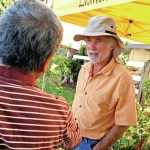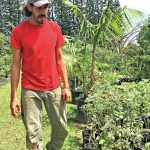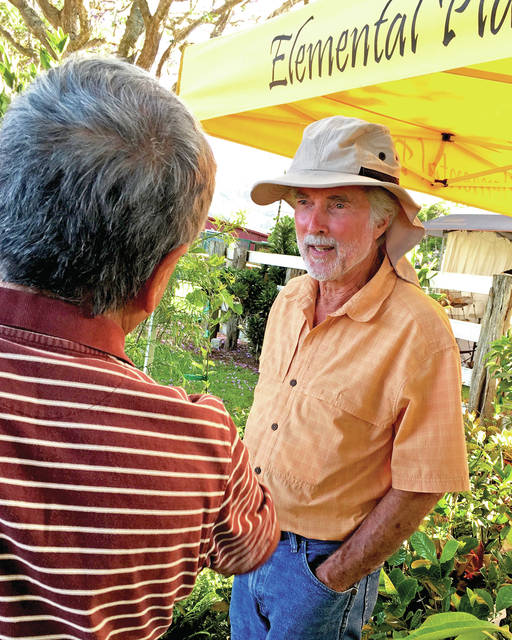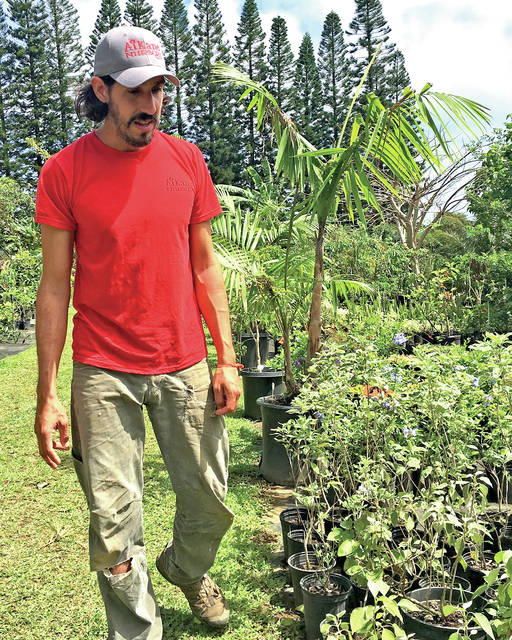WAIMEA — “We cannot be complacent about invasive species,” said Kari Hagerman of Pomaikai Plant Company, a well-known grower of vegetables, herbs and bedding plants in Waimea. “Just because they are here doesn’t mean we can’t deal with the problem.”
WAIMEA — “We cannot be complacent about invasive species,” said Kari Hagerman of Pomaikai Plant Company, a well-known grower of vegetables, herbs and bedding plants in Waimea. “Just because they are here doesn’t mean we can’t deal with the problem.”
Hagerman, a regular vendor at the Saturday Kamuela Farmers Market at Pukalani Stables, along with dozens of Plant Pono endorsed nursery owners around the Big Island, takes responsibility for her plants as potential vectors for movement of pests like fire ants and coqui frogs. These growers follow self-imposed protocols for containing and controlling the noxious hitchhikers.
Plant Pono is an environmental program to promote the propagation of noninvasive plants and to support growers who agree to discontinue the sale of plants that pose a risk to local ecosystems. On Hawaii Island, the program is being implemented by the Big Island Invasive Species Committee and supports nurseries and landscapers who follow procedures to reduce the spread of pests via plant materials.
“When I bring in plants from responsible growers in Hilo that I work with, the plants go through a two-phase quarantine,” said Hagerman. “First, they are quarantined and tested for ants and frogs in Hilo before they are put on the truck. Then after they are delivered to her nursery in Waimea, they are quarantined and tested again. Only when they are deemed to be clean of pests are they offered for sale to landscapers and the public.”
She lived in Hilo at the time that coqui frogs were first found there, and learned from that experience. Hagerman relates the story of how inaction in those early stages of infestation led to the huge problem that residents face today. Like many others in the Hilo area, she heard those first frogs, but there was no urgency to address the infestation at that time, she said.
This knowledge clearly motivates her current response to reports of coqui near any of her plants, both in her own nursery and at stores like the Waimea Ace Hardware where she stocks plants.
“Even with careful procedures in place, I will still find a frog every now and then,” Hagerman said.
Her reaction demonstrates her ongoing commitment to controlling the spread of invasive species.
“I will go out at night to chase down that one calling frog near my plants,” she said.
That commitment to high standards of professional conduct characterizes other North Hawaii growers as well.
“I carry peanut butter in my truck,” said Michael Gibson of Elemental Plants, another plant vendor at Kamuela Farmers Market as well as the Sunday Hamakua Harvest market in Honokaa.
Peanut butter bait is used to test for fire ants, and he is proactive in testing his plants and teaching customers about the dangers of these pests to their homes, farms and local ecosystems.
Growers like Gibson who interact with the public at farmers markets often find themselves as the sole source of information to plant lovers about everything from suitability of plants for local conditions to diagnosis of sick plants.
“People are often looking for the quick fix,” he said.
Gibson not only helps them with their gardening problems but also understands the role of plants as a means to restore and enhance people’s relationship to the land.
“Everyone needs that connection to the land,” he said.
“People in Kohala are tuned in to invasive species,” said Brad Belmarez, owner of Aikane Nursery in Hawi. “My audience is aware.”
The Plant Pono program on the Big Island has identified a few key invasive plant species that are common in local yards and gardens but have shown themselves to be reckless invaders in both agricultural and natural landscapes. These are the plants being targeted for removal from stocks at nurseries and home centers.
“Some of the big bad guys for our island are night blooming jasmine, Australian tree fern, Mexican flame vine and New Zealand flax,” said Molly Murphy, BIISC’s Plant Pono coordinator.
Aikane Nursery is a Plant Pono endorsed business, and Belmarez and his staff resonate with not only the mission of reducing invasive plants in local landscapes, but also the underlying ethic of restoring a sustainable relationship between people and plants. He has a special passion for native Hawaiian species and includes them in every landscape he works on.
“There is something special about native plants,” Belmarez said. “Native plants are soft and subtle, and every one has a story. Most people don’t know much about native plants, nor how well adapted they are to our local conditions.”
For example, the constant trade winds of Kohala pose problems for many homeowners. Belmarez has demonstrated that many native and noninvasive trees are perfectly adapted to grow in strong winds, including kou, kamani, ohia, milo, kukui and hau. He sells all of these trees at Aikane and teaches his customers about their adaptations, preferred range and special characteristics.
In addition to publishing lists of plants to avoid, Plant Pono also provides analysis of new species for their potential invasiveness, using a program called the Hawaii Pacific Weed Risk Assessment. This test is like a background check for plants that gives an idea of how invasive they can be, said Murphy. Ranking of a six or higher in the HPWRA is like a red flag and means that the plant is very likely to be a problem.
“There are so many plants that are good for Hawaii,” said Murphy. “Plants provide food, cover, wildlife habitat and beauty. It’s really not that hard to avoid the plants that are hazardous to our communities and ecosystems. We just need to spread awareness.”
Belmarez added, “It’s about the plants. It’s about the community. We all play a role.”
Plant Pono program info: Go to https://plantpono.org
For questions or to become an endorsed business, email the BIISC Plant Pono Coordinator Molly Murphy at mollym3@hawaii.edu






